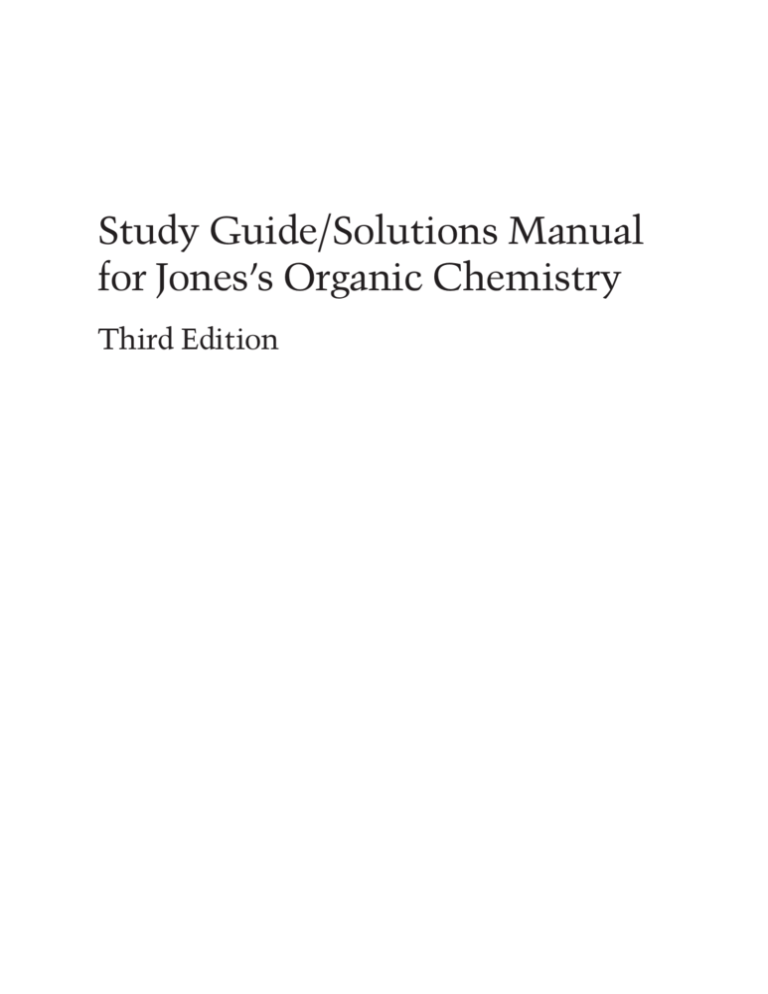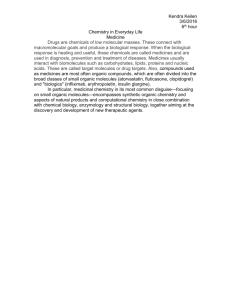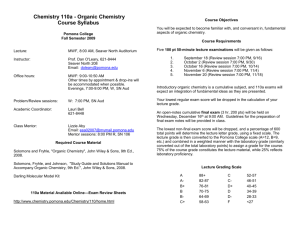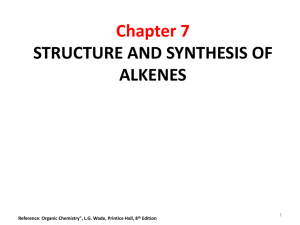
Study Guide/Solutions Manual
for Jones’s Organic Chemistry
Third Edition
Study Guide/Solutions Manual
for Jones’s Organic Chemistry
Third Edition
M A I T L A N D J O N E S , J r.
a n d H E N RY L . G I N G R I C H
Princeton University
W
•
W
•
N O RT O N & C O M PA N Y
NEW YORK
•
LONDON
Copyright © 2004, 2000, 1997 by W.W. Norton & Company, Inc.
All rights reserved
Printed in the United States of America
Manufacturing by R. R. Donnelley
Book design by Rubina Yen
Director of Manufacturing/College: Roy Tedoff
ISBN 0-393-92458-0 (pbk.)
W.W. Norton & Company, Inc., 500 Fifth Avenue, New York, N.Y. 10110
www.wwnorton.com
W.W. Norton & Company, Ltd., Castle House, 75/76 Wells Street, London, W1T 3QT
1 2 3 4 5 6 7 8 9 0
This book is dedicated to the generations of undergraduates upon whom
we have inflicted this collection of problems, solutions, and advice. For
the most part, they have borne this burden with remarkable good cheer.
vii
Contents
Introduction
ix
Chapter 1: Atoms and Molecules; Orbitals
and Bonding
1
Chapter 2: Alkanes
41
Chapter 3: Alkenes and Alkynes
Chapter 4: Stereochemistry
Chapter 5: Rings
71
105
127
Chapter 6: Alkyl Halides, Alcohols, Amines,
Ethers, and Their Sulfur-Containing
Relatives
153
Chapter 7: Substitution and Elimination Reactions:
The SN2, SN1, E2, and E1 Reactions
165
Chapter 8: Equilibria
213
Chapter 9: Additions to Alkenes 1
223
Chapter 10: Additions to Alkenes 2: Additions
to Alkynes
263
Chapter 11: Radical Reactions
299
Chapter 12: Dienes and the Allyl System: 2p Orbitals
in Conjugation
325
Chapter 13: Conjugation and Aromaticity
Chapter 14: Substitution Reactions of
Aromatic Compounds
387
Chapter 15: Analytical Chemistry:
Spectroscopy
431
361
Chapter 16: Carbonyl Chemistry 1:
Addition Reactions
471
Chapter 17: Carbonyl Chemistry 2: Reactions at
the -Position
513
Chapter 18: Carboxylic Acids
577
Chapter 19: Derivatives of Carboxylic Acids:
Acyl Compounds
609
Chapter 20: Special Topic: Aromatic Transition States;
Orbital Symmetry 677
Chapter 21: Special Topic: Intramolecular Reactions and
Neighboring Group Participation 711
Chapter 22: Special Topic: Carbohydrates
743
Chapter 23: Special Topic: Introduction to
Amino Acids and Polyamino Acids
(Peptides and Proteins)
779
Introduction
I
n this Study Guide we try to go beyond straightforward “bare bones” answers to problems. Once one
gets past simple questions, problem solving in organic chemistry becomes very hard to teach. The
answers to many problems are intuition-intensive, and therefore it becomes difficult to explain in
explicit terms how to proceed. Nonetheless there are things that can be said that may help; there are
techniques of problem solving that can be learned. In this collection of comments on solutions to all of
the problems that are not solved in the text itself, we try to help you to do that. As in the text, we seek in
these pages to show you how to approach problems in organic chemistry in general, not just how we got
from here to there in specific cases.
The exercises in these chapters become much easier when we have an idea of where we are going.
What exactly are we trying to do in this problem? What tasks must be accomplished? What bonds are we
trying to make or break? What rings must be closed or opened? Such questions seem simple, but it is
amazing how few people really start problems with the simple question: “What happens in this reaction?” Analyze! Once a goal is in mind, the path to that goal becomes much, much easier. In a sense, a
good problem solver has learned, first and foremost, to avoid “thrashing.” We know that is a flip remark,
but it is, nonetheless, true. A person solving a tough problem is like a bacterium swimming up a food
gradient—he or she (or it) is following a pathway that “feels good.” We will try to show you how to do
that in this Study Guide, but there can be no denying that experience is important, and experience can be
gained only by practice. Practice and more practice will teach you what feels good in terms of problem
solving—of how to swim up that food gradient—but we will try to give you some hints along the way.
The problems solved in the Study Guide will recapitulate each chapter, and thus will generally start
off with the easier examples and then go on to tougher stuff. Don’t worry if the hard problems at the end
of the sections do not come so easily; they are meant to tax you, to demand some hard work and careful
thought. Some difficult problems will be dealt with best over time. If a problem resists solution, and
some will, come back to it after a while; let your subconscious work on it for a while. Most research
chemists carry unsolved problems around in their heads for a long time, sometimes for years, returning
to them now and then. There is nothing wrong with emulating that process. People think at vastly different rates, and it is a rare situation that requires a rapid solution of a problem. (Hour exams may be an exception, unfortunately.)
Many of us who actually do organic chemistry for a living (believe it or not there are such people) typically get great pleasure from problem solving. We hope that you will be similarly stimulated. In a fundamental way that is what we humans are about. We have evolved to be curious and to turn over rocks to
see what is underneath. Perhaps, thinks our ancestral hunter-gatherer, I will find something good to eat!
From such imperatives we humans have become problem solvers, and it gives us pleasure to work out
what’s happening in unknown situations.
x
Introduction
The two of us have solved a good many problems together, and it is great fun. Here is one favorite example, which makes an important point about problem solving. This lesson is so simple as to be trivially
obvious and yet at the same time so profound as to be most difficult in practice. We had been working for
some time on the synthesis of the pterodactyl-shaped compound shown below.
One of us (MJ) had become entrapped in devising increasingly clever “solutions” that a series of graduate students and undergraduates had not been able to make work—and for good reasons. Those clever
solutions were complicated, and extraordinarily hard to carry out in a practical sense. While MJ was away
one July, HG had the wit to avoid all the foolish “cleverness” and to do what we beseech our students to
do—to “think simple.” HG went back to basics, did the work himself, and solved the problem. MJ arrived back in Princeton and was presented with a vial containing exquisitely beautiful crystals of the
long-sought compound. What’s the lesson? Don’t be too clever. If you ground yourself in the basics, analyze what you want to do, and then apply those basics, you will prosper.
Remember, think simple. As Ted Williams is supposed to have said: “If you don’t think too good, don’t
think too much.”
Maitland Jones, Jr.
Henry L. Gingrich
Study Guide/Solutions Manual
for Jones’s Organic Chemistry
Third Edition









